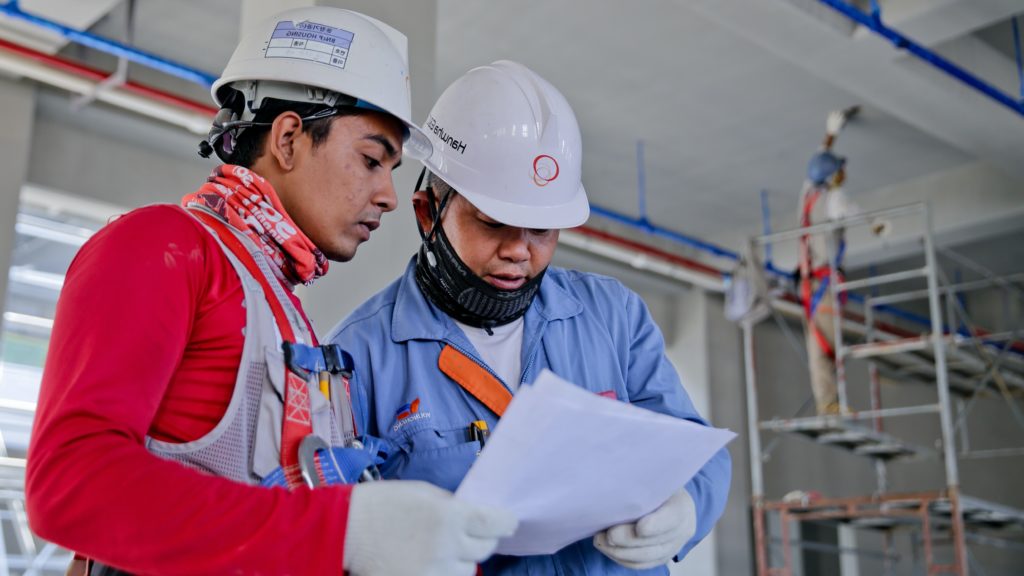As summer winds down, it’s essential to consider how your facility and operations will change with the seasons. In most parts of the country, the days will get shorter, and the weather will turn colder. You’ll likely be closing windows and doors to keep in the heat.
But a more comfortable temperature could cause a significant change in indoor air quality (IAQ).
October is Indoor Air Quality Awareness Month. In recognition, we thought it would be an excellent time to discuss how IAQ fits into a comprehensive EHS plan for your business.

Indoor Air Quality has to do with the presence or absence of irritants, contaminants, or hazards in the air within and around a building.
Testing indoor air quality allows you to identify the existence of any issues that could pose a threat to occupants’ safety.
A systematic approach to permanent solutions or ongoing monitoring and mitigation can be developed when IAQ issues are identified.
The last time we checked, everybody needed to breathe. And according to the Environmental Protection Agency, Americans spend up to 90% of their time indoors.1 That makes indoor air quality something that every organization needs to consider.
The fall is an excellent time to consider indoor air quality inspections. Schools are back in session. Commercial buildings and industrial facilities will likely begin shutting things in and turning the heat on. The same is true for multi-family housing units. Healthcare facilities need to be constantly vigilant against biohazards and airborne pathogens.
What should you expect when you work with environmental health and industrial hygiene specialists on an indoor air quality survey of your facility?
The first step in the process focuses on gathering data that will determine the overall quality of the air in your buildings. Technicians will collect samples of the air and from surfaces. They will investigate to identify any pollutants as well as the sources. They will also study the airflow in your building.
Once the survey is complete and the results have been analyzed, you will receive a report that documents the results and identifies the presence of any hazards, irritants, or other concerns. And recommendations
A qualified environmental health consultant can help you develop a strategy to remediate, eliminate, or isolate any air quality concerns identified during the survey. This might involve humidification, filtration, ionization, or ultraviolet germicidal irradiation (UVGI).
What happens if the source of the problem is part of your regular operations? Your consultant will help you develop a plan for engineering controls and periodic monitoring.
Everybody benefits from an indoor air quality survey. Suppose your IAQ survey doesn’t identify any issues requiring further action. In that case, you and your employees, students, or patients will know they can “breathe easy.”
Whenever an IAQ survey identifies areas of concern, there are benefits to knowing what they are and taking steps to resolve them.
Mold, mildew, and volatile organic compounds (VOCs) can cause odors that bother workers or customers. High particulate levels can lead to inefficient HVAC operations that raise heating and cooling bills. IAQ issues can cause or exacerbate health concerns like asthma, allergies, COPD, headaches, and even cardiac conditions.
Beyond the hygienic and comfort aspects of air quality, business benefits come from boosts in employee performance and productivity as well as reductions in absenteeism, which could increase the bottomline.
SITEX works with companies from a wide range of industries to help them survey, monitor, and improve the air quality in their facilities.
Some businesses are concerned about everyday air quality issues like odors, dust, and humidity. Others need us to help them determine if mold, mildew, radon, asbestos, or benzene are present at levels threatening their employees’ health.
Work with SITEX on indoor air quality. You can trust that we have the expertise and experience to identify any hazards. We can develop the right plan for your business to follow in mitigating IAQ issues.
1 U.S. Environmental Protection Agency, Report to Congress on indoor air quality: Volume 2, 1989.